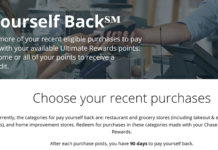NOTICE: This post references card features that have changed, expired, or are not currently available
One of the best ways to increase point earnings or cash back when buying merchandise is to double dip: first get the most points or cash back possible from buying the merchant’s gift cards, then get the most points or cash back possible when using the merchant’s gift cards to buy things. For background on getting points & cash back from buying gift cards, please see: “Best options for buying merchant gift cards.” And, for a few examples of double dipping, please see:
The downside
The downside of using gift cards to buy merchandise is that you forfeit the purchase protections often automatically offered by credit cards. These include: purchase protection, return protection, extended warranty, and price protection. It’s a good idea to weigh the value of these benefits against the value of extra points earned when considering a gift card double dip.
What if I put 1 cent on my credit card?
I’m often asked whether you’ll get purchase protections if you make most of a purchase with gift cards and pay a small amount with your credit card. Would that result in extended warranties and other benefits?
I did some research on this over the weekend. As expected, most credit cards’ benefits guides explicitly say that a purchase must be made entirely with your credit card for the benefit to apply. There were a few exceptions though…
Chase Ink, Freedom, and Sapphire
Recently, Chase updated the Chase Ink Plus, Ink Bold, Sapphire, Sapphire Preferred, and Freedom benefits guides (they may have updated others as well, but these are the ones I’m aware of). In the old benefits guides, the purchase perks were explicitly limited to purchases made entirely with your card. In the new guides, though, they explicitly say that you must “charge some portion of the item’s purchase price to your Account or use reward points earned on your Account toward the purchase.” This new language is present for all four types of purchase perks: purchase protection, return protection, extended warranty, and price protection. This is great news right? Well, it’s good, but not necessarily as great as it sounds. I’ll discuss below how this applies to each perk individually. First, though, let’s look at other cards…
American Express
I checked the benefits guides of a few American Express cards and found mixed results. Purchase Protection applies when any portion of the purchase is made with your card. Return protection, though, which only applies to select American Express cards, only applies when the purchase is made entirely with your card. The extended warranty is less clear about whether it applies to partial purchases, but I think it does. And, finally, American Express no longer offers price protection so that doesn’t apply either way.
Other cards
I looked up the benefits of a number of other cards. All of the following require the entire purchase to be made with your card for benefits to apply:
- Chase United MileagePlus
- Chase Priority Club Visa
- Chase Marriott Rewards Premier
- Chase British Airways
- Discover It
- Capital One Visa
- Barclaycard US Airways
- Citi ThankYou Preferred (including “Price Rewind”)
- Citi ThankYou Premier (including “Price Rewind”)
Does it matter?
Even when Chase and American Express say that you’re covered when you charge some portion of a purchase to your credit card, that doesn’t mean you’re fully covered. In each case, they also say that “you will only be reimbursed up to the amount charged to your Account or the program limit, whichever is less.” Let’s look at each perk and see what that means:
Purchase Protection: This benefit typically covers accidental damage, theft, or loss of the item you purchased. The Ink Bold and Ink Plus cards cover up to $10K per item for up to 120 days after purchase. The Sapphire and Freedom cards covers up to $500 per item up to 120 days after purchase. If you put just a small percentage of the items cost on your credit card, then that is the maximum reimbursement you can get if something bad does happen.
Return Protection: This protection applies when you buy something and want to return it, but the merchant you bought from won’t accept the return. The Ink Bold, Ink Plus, and Sapphire cards cover up to $500 per item for 90 days after purchase. The Freedom card covers up to $250 per item, also for 90 days. If you put just a small percentage of the item’s cost on your credit card, then that is the maximum reimbursement you can get if you use return protection.
Extended Warranty: Most credit cards offer to extend warranties for an additional year beyond any automatic store or manufacturer warranties. If you put just a small percentage of the items cost on your credit card, then that is the maximum reimbursement you can get if you file a claim.
Price Protection: This benefit applies when an item you recently purchased drops in price. With the Chase Ink, Sapphire, and Freedom cards, you are covered for 90 days as long as you paid partially with your card. This is the one protection where I see a big potential benefit to this partial coverage. Let’s say you think the purchase price of an item may drop by up to 20% in the next 3 months after purchase. In that case, assuming I’ve read the benefits guide accurately, if you pay 20% of the total with your Ink Plus, Ink Bold, Sapphire, or Freedom card, you should be fully covered for that drop in price. In fact, I recently bought some furniture this way. Crate & Barrel frequently has 15% off furniture sales, but I wanted to buy immediately, so I put a little over 15% on my Freedom card and paid the rest with gift cards. If they hold another 15% off sale within the next 90 days, I’ll have the opportunity to test this partial coverage!
Pondering options
Most credit card purchase perks exclude shipping and handling (and probably sales tax) from the allowed amount of any reimbursement. So, when using a card that offers partial coverage when paying partially with a gift card, I think that it can’t hurt to pay for at least those things (shipping & handling, and sales tax) with a gift card. Another approach that would most likely work is to purchase multiple items at once and use a credit card to pay for just the most expensive of the items. For example, suppose you buy three items at once, two for $300 each and one for $400. If you pay $400 of the total with your Ink Plus, Ink Bold, or Freedom credit card, but pay the rest with gift cards, then I think you basically have full coverage. As long as you don’t ever file a claim for more than one of the three items, you should be OK. Of course, this is just my read of it right now. I haven’t tested this theory.
Bottom line
Credit card purchase perks usually only apply when you pay 100% with your credit card. With some cards, though, you are covered even when you pay partially with your card. In that case, your coverage is only up to the amount you paid with your card. As I discussed above, Price Protection is one area where partial coverage may be good enough. With other protections, you could try the approach of paying just for the most expensive item on your receipt with a credit card and pay for the rest with gift cards (see “Pondering options,” above). Otherwise, it is necessary to balance the piece of mind you get from having the protection vs. the points given up if you pay by credit card rather than by gift card. Personally, I usually opt for the points because I’m willing to bet that I won’t ever want to file a claim. In rare cases, though, it may be worth giving up a few points to get the extra protection.





You will not generally get protection for your dishwasher. I just tried with Visa and they told me since it was connected to the drain, it had become part of the real estate and was excluded “like a garage door”. The agent told me no person would ever take a dishwasher out once installed, so it is no longer a “portable appliance” which is all that is covered.
Yikes. Thanks for the word of caution.
I just had the same experence: 1 1/2 year old Maytag dishwasher failed. I purposely used my Visa for the extended warranty only to find it is not covered. Not understanding why my fridge at 5x’s the cost is covered but not the dishwasher. Back to reading the ALL the fine print :/
Did you ever check on what happens if you cancel the credit card and need the warranty? Specifically, Chase Sapphire Preferred is what I am wondering about. I never considered this before and now I have a broken dishwasher.
Great question. No, I’ve never looked into that. If you find out, can you let us know?
I bought a new laptop August 8 with my Freedom card and a friend damaged it August 28 causing $800 in damages. I did not know about purchase protection, so I did not report it. Then this weekend (Nov. 24) my laptop was stolen from my house. I called to file a claim, but was told that both incidents are not covered because the benefits were different before Nov. 1, 2013 (the benefits you posted here are the new benefits, effective only on purchases AFTER Nov. 1). Apparently the old benefits only cover 90 days after the purchase and within 60 days of notifying Chase, so neither incident was eligible. I was told I could still continue that claim, and ultimately the claims department could decide whether they are eligible. Does anyone know if I even have a chance at getting even just part of it covered? Any advice?
Most homeowners policies and some auto policies will cover the theft of a laptop…….Good Luck!
[…] INS AND OUTS OF CREDIT CARD GUARANTEES: Thanks also to Frequent Miler for doing some legwork in figuring out whether standard credit card protections apply when you partially pay with gift cards. Bottom line: it depends. For […]
[…] Credit card purchase perks and how they apply when using gift cards […]
Amit: That’s a great question. I expect that you would have to still have the card, but I’ll have to double check the fine print…
What happens to the warranty or other benefits after a purchase was made and lets say a year down the road you cancel the card? Would the CC companies still honor the warranty as the original purchase was made when the credit card was active?
[…] INS AND OUTS OF CREDIT CARD GUARANTEES: Thanks also to Frequent Miler for doing some legwork in figuring out whether standard credit card protections apply when you partially pay with gift cards. Bottom line: it depends. For […]
Forgive me for being so off the wall but I just had an out of body experience……..I just booked my two kids on US miles for a trip from SFO-YUL-CDG on Air Canada then after 4 days CDG-ZRH-BCN on Swiss then after 8 days BCN-MUC-SFO on Lufthansa and all for 60k and done very painlessly by US Air……..I had to provide the initial Air Canada flight numbers as I surfed them on United but the US Air agent found the return thru Munich that even United did not show. I demanded to talk to his supervisor and apologized for all the bad press we (and me) give US Air…..totally unrelated to this topic (somewhat) but a truly mystical experience that makes chasing all these deals ultimately worthwhile! And a great, cheap gift to my kids……..
justSaying: That’s fantastic. Well done.
Some of these extended protections are well worth the full price. Usually TV and electronics are very reliable these days, and there is no need to buy extended warranties from stores or places like Squaretrade.
I used to work for a large insurance corporation and most of those extended warranties you get in a store are actually bought from companies like the one I used to work for. Even credit card extended warranties are satisfied using our contracts. The markups at the store are HUGE. That is the reason credit cards offer this perk for free.
But the fine print is very long and for big ticket items you may want to use cards like Amex, who offer exceptional CS.
My 0.02
I buy Starbucks and Shell gift cards on a regular basis and my wife buys Sears and Bed, Bath & Beyond gift cards frequently all getting 5x. But keeping track of the gift card warranty info really makes you want to just use one of the mileage cards for those purchases……..there seems to be a point where those of us who have killed some of our brain cells on youthful pleasures just can’t compute all those numbers simultaneously…….if you can my hat is off to you………..
Surprised you didn’t mention rental cars, probably the most common usage for a claim. Especially with Primary Coverages (when used for business) the Inks look to be the way to go if partial payment triggers the insurance requirement.
james: This post was focused just on buying “stuff”. I may do another post about credit card travel protections including rental cars.
.
JustSaying: I agree. In general, I simply don’t worry about not having extended warranties, etc. It only matters to me with certain big ticket items.
.
Jorge: I agree 100% that store bought extended warranties are a huge waste of money. So, to me, the question is whether to get the credit card’s automatic protection or nothing (when paying with gift cards).
I have bought four tires and in another purchase eight sets of crystal stemware. I paid for one tire and one set of stemware to get coverage for breakage/damage/defects. The others I paid for with gift cards. With glass and easily breakable items you need to protect yourself with a minimal investment or loss of points/miles. Even I don’t know which tire was paid for with the credit card.
How would this play out with airline travel? Not talking about price protection but lost luggage, delays, etc.
Example: Many of us have AA gift cards from Citi so if I book a trip (Cathay F of course) from LAX-HKG using AA miles, pay part of ticket with gift card and part with Citi AA card….do I still get trip interruption coverage, lost luggage payments, etc.?
Thanks!
Price and return protection seem to be the most usable. However, if constantly filing claims for price or returns, does it put a red flag on your account in any way?
Just trying to consider account impacts or status with the providing bank…I would rather have regular credit approval for large bonuses on new area rather than having my accounts flagged for repeat claims.
Thoughts?
Dave: I’m pretty sure that the benefit administration for things like price protection and returns are handled completely separately from the bank’s other operations. I doubt very much that it would raise any flags. They do have limits in place as to how often and how much you can file for.
.
Jon: That’s a great question. There might be a nice opportunity there to get meaningful trip insurance without paying for it. I’ll try to scour the fine print.
.
Topspinner: Great idea.
In a strange irony of timing. This afternoon a new guide to benefits arrived in my mailbox for the Sapphire Preferred card (and also the regular Sapphire). It is now the same as the Ink and Freedom cards with respect to saying “any portion of”. I’ll update the post.